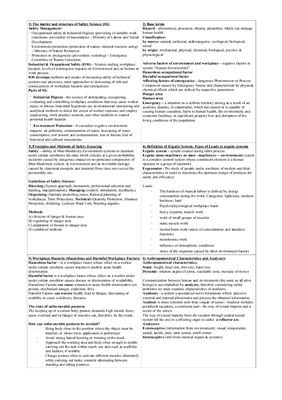Препод.: Цвиленева Н.Ю.
The matter and structure of Safety Science.
Base terms.
Principles and Methods of Safety Ensuring
Definition of Ergatic System. Types of Loads in ergatic systems
Workplace Hazards (Hazardous and Harmful Workplace Factors)
Anthropometrical Characteristics and Analyzers
Reliability of Operator and Man-Machined Systems
Risk as integral measure of danger. Risk Assessment.
Lighting of a Workplace: Base terms and characteristics
Sorts and systems of lighting
Workplace lighting requirements and standards: artificial and natural lighting
Lighting requirements for workplaces with monitors
Sources of artificial lighting
Air pollution: sources of air pollution, main pollutants, classifications of pollutants
The impact of noxious substances on a human health, standards for air quality
Ventilation: calculation
The microclimate of workplaces: Impact of microclimate on human health. Parameters of microclimate, standards, devices
Noise: Definition, the frequency range of Noise. Impact on human health. Classification of Noise
Measures of Noise.
Noise limiting Standards for steady and unsteady noise.
Noise Protection.
Ultrasound radiation. Health effects. Standardization. Protection.
Infrasound radiation. Health effects. Standardization. Protection
Vibration. Health effects. Standardization. Protection.
Electromagnetic non-ionizing radiation: Electromagnetic fields (EMF): physics, measures.
Sources of electromagnetic fields and radiation. Possible health effects.
Hygiene Standardization of EMF and protective measures.
Ultraviolet radiation. Health effects. Standardization. Protection.
Infrared radiation. Health effects. Standardization. Protection.
Lasers. Health effects. Standardization. Classification of lasers bygrade of danger. Protective measures.
Ionizing radiation: Types of ionizing radiation. Sources of ionizing radiation.
Measuring of ionizing radiation. Measure units.
Possible health effects of ionizing radiation.
Hygienic standards of ionizing radiation. Protective measures.
Electrical Safety: The body's response to Electricity
Hazards of electrical traumas at different schemes of body’s engage into circuit in normal condition
Hazards of electrical traumas at Electrical device malfunction
General electrical safety precautions.
Environment Protection: Air Protection
Environment Protection: Water Protection
Environment Protection: Solid Waste Managment
Methods of identifying workplace hazards
FaultTree and EventTree Analysys
Emergencies: Definions and types of an emergencies. Phases of emergencies.
Natural disasters. Classification and main characteristics.
Accidental and societal-conflict emergencies. Mass-destruction weapons.
Affecting factors of technogenic emergencies.
Affecting (destructive) factors of mass-destruction weapons.
Emergency/disaster prevention and response plan.
Specific emergency situations: Fire Safety and Fire Protection. Elements of Buing Theory
Fire Protection: active Fire Protection, passive Fire Protection. The Fire Code
Procedures to follow in the event of a Fire: Fire prevention, Fire containment, Evacuation.
Safety management. Labor protection management. Investigation of mishaps.
Management in emergencies.
Environment safety management. Ecological expertise. Ecological monitoring.
Base terms.
Principles and Methods of Safety Ensuring
Definition of Ergatic System. Types of Loads in ergatic systems
Workplace Hazards (Hazardous and Harmful Workplace Factors)
Anthropometrical Characteristics and Analyzers
Reliability of Operator and Man-Machined Systems
Risk as integral measure of danger. Risk Assessment.
Lighting of a Workplace: Base terms and characteristics
Sorts and systems of lighting
Workplace lighting requirements and standards: artificial and natural lighting
Lighting requirements for workplaces with monitors
Sources of artificial lighting
Air pollution: sources of air pollution, main pollutants, classifications of pollutants
The impact of noxious substances on a human health, standards for air quality
Ventilation: calculation
The microclimate of workplaces: Impact of microclimate on human health. Parameters of microclimate, standards, devices
Noise: Definition, the frequency range of Noise. Impact on human health. Classification of Noise
Measures of Noise.
Noise limiting Standards for steady and unsteady noise.
Noise Protection.
Ultrasound radiation. Health effects. Standardization. Protection.
Infrasound radiation. Health effects. Standardization. Protection
Vibration. Health effects. Standardization. Protection.
Electromagnetic non-ionizing radiation: Electromagnetic fields (EMF): physics, measures.
Sources of electromagnetic fields and radiation. Possible health effects.
Hygiene Standardization of EMF and protective measures.
Ultraviolet radiation. Health effects. Standardization. Protection.
Infrared radiation. Health effects. Standardization. Protection.
Lasers. Health effects. Standardization. Classification of lasers bygrade of danger. Protective measures.
Ionizing radiation: Types of ionizing radiation. Sources of ionizing radiation.
Measuring of ionizing radiation. Measure units.
Possible health effects of ionizing radiation.
Hygienic standards of ionizing radiation. Protective measures.
Electrical Safety: The body's response to Electricity
Hazards of electrical traumas at different schemes of body’s engage into circuit in normal condition
Hazards of electrical traumas at Electrical device malfunction
General electrical safety precautions.
Environment Protection: Air Protection
Environment Protection: Water Protection
Environment Protection: Solid Waste Managment
Methods of identifying workplace hazards
FaultTree and EventTree Analysys
Emergencies: Definions and types of an emergencies. Phases of emergencies.
Natural disasters. Classification and main characteristics.
Accidental and societal-conflict emergencies. Mass-destruction weapons.
Affecting factors of technogenic emergencies.
Affecting (destructive) factors of mass-destruction weapons.
Emergency/disaster prevention and response plan.
Specific emergency situations: Fire Safety and Fire Protection. Elements of Buing Theory
Fire Protection: active Fire Protection, passive Fire Protection. The Fire Code
Procedures to follow in the event of a Fire: Fire prevention, Fire containment, Evacuation.
Safety management. Labor protection management. Investigation of mishaps.
Management in emergencies.
Environment safety management. Ecological expertise. Ecological monitoring.

